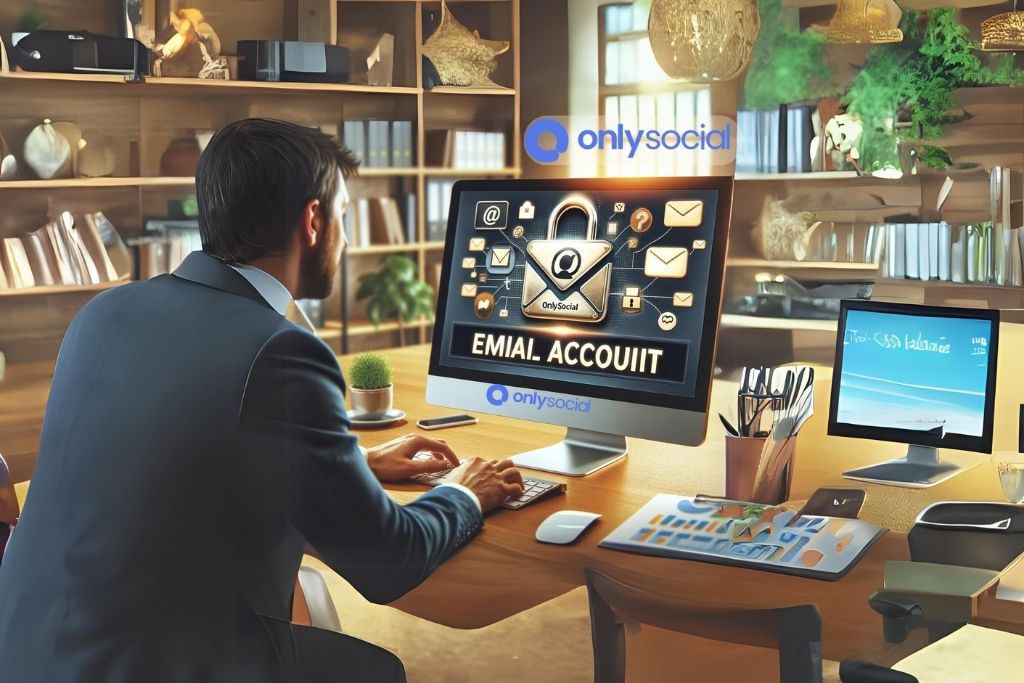Email Account Security: How to Keep Your Data Safe from Cyber Threats in 2025

In today’s digital age, keeping your email account secure is more important than ever. Our inboxes often hold sensitive personal and professional information that, if compromised, could lead to devastating consequences. Email Account Security is crucial in preventing unauthorized access and protecting your data from cybercriminals lurking in the virtual world.
With an ever-increasing number of online threats, it’s vital to understand the security risks associated with email accounts, know the best practices to safeguard your inbox and stay ahead of hackers by implementing strong and proactive measures. This comprehensive guide on Email Account Security will not only help you learn about these risks, but will equip you with the necessary tools and techniques to secure your inbox and protect your privacy.
Table of Contents
Understanding Email Security Threats
To effectively protect your inbox and ensure your Email Account Security, it’s essential to familiarize yourself with various types of threats that target email users. By gaining an understanding of these risks, you’ll be better equipped to identify potential vulnerabilities and mitigate any damage that could arise from cybersecurity breaches.
Common Email Security Threats
Below are some of the most common email security threats that pose a risk to your email account and could potentially compromise your data:
1. Phishing
Phishing attacks involve fraudulent emails designed to trick recipients into revealing sensitive information or downloading malicious attachments. These emails often impersonate legitimate businesses or organizations and exploit human trust. Phishing is one of the most prevalent email-based threats and can lead to severe consequences if not handled carefully.
2. Spam
Spam refers to unwanted, unsolicited messages sent to your inbox, usually in bulk. These emails can range from harmless advertisements to those containing malicious attachments or links that, when clicked, can infect your device with malware. While spam is a nuisance and can clutter your inbox, it may also pose a risk to your email account security.
3. Malware
Malware is malicious software designed to infiltrate, damage, or perform unwanted actions on a user’s device or network. It can take various forms, including viruses, worms, Trojans, and ransomware. Malware can be spread via email attachments, links, or even seemingly legitimate files, which can put your email account security at risk.
4. Account Takeover
Account takeover (ATO) occurs when cybercriminals gain unauthorized access to a user’s email account, often through stolen credentials or by exploiting weak passwords. Once inside the account, attackers can send emails from your address, steal sensitive information, and even lock you out of your account.
| Threat | Description | Potential Consequences |
|---|---|---|
| Phishing | Fraudulent emails tricking users into sharing sensitive info | Stolen data, compromised accounts, financial loss |
| Spam | Unwanted messages, sometimes containing malicious content | Cluttered inbox, increased risk of malware infection |
| Malware | Malicious software harming your device or network | Data theft, damaged devices, financial loss |
| Account Takeover | Unauthorized access to a user’s email account | Stolen data, compromised reputation, loss of control |
By recognizing these threats and implementing robust Email Account Security measures, you can minimize the risks posed to your inbox and the sensitive information it holds.
Best Practices for Email Account Security
When it comes to securing your inbox, knowledge is power. It starts with understanding the various threats and then implementing Email Account Security best practices to mitigate these risks. Let’s delve into some practical tips you can apply to safeguard your email account.
1. Create Strong and Unique Passwords
Use a combination of letters, numbers, and special characters to create a secure password that’s tough to crack. Don’t use common words or phrases — the more random, the better! Consider using a password manager to generate and store complex passwords securely. Remember to change your passwords periodically for added security.
2. Implement Two-Factor Authentication (2FA)
Two-factor authentication adds an extra layer of security to your email account. When 2FA is enabled, access to your account requires something you know (your password) and something you have (like your mobile device or a special key). If a hacker somehow deciphers your password, they would still need the second factor to access your account.
3. Recognize and Avoid Phishing Attacks
Never click on links or download attachments from unknown senders. Be cautious with emails that ask for personal or financial information and keep an eye out for spelling errors and suspicious email addresses — these are common indicators of phishing emails.
4. Keep Software and Security Tools Up-To-Date
Software updates often include patches for newly discovered vulnerabilities. Keep your operating system, web browsers, antivirus software, and other security tools up-to-date to ensure you have the latest protections.
5. Regularly Review and Update Security Settings
Ensure that your email account’s security settings are configured to provide maximum safety. This might include enabling automatic encryption of emails or setting up alerts for suspicious login activities.
6. Monitor Account Activity for Suspicious Logins
Regularly review your account’s login activity. Many email service providers offer this feature, allowing you to monitor when, where, and on what device your account is accessed. If you spot any unusual activity, it might suggest that your account has been compromised.
By adopting these best practices, you can greatly enhance the security of your email account and protect your sensitive information from potential threats. Email Account Security requires continuous attention and proactive measures. So, start applying these measures today and take control of your online security.
Using Trusted Email Providers and Tools
The choice of email providers can significantly impact your Email Account Security. Therefore, it’s essential to opt for reputable providers, which prioritize security and privacy above other aspects. Also, integrating additional tools can augment your efforts, ensuring your inbox is as secure as possible.
Trusted Email Providers
Here are a few trusted email providers known for their robust security measures:
1. Gmail
Google’s email service, Gmail, provides users with advanced spam filters, suspicious activity alerts, and 2FA to secure user accounts. In addition, Google is known for its robust anti-phishing capabilities and proactive measures against cybersecurity threats.
2. Outlook
Outlook by Microsoft offers strong security features, including automatic email encryption, suspicious email warnings, and 2FA. Additionally, it allows regular security updates for a safe emailing experience.
3. ProtonMail
ProtonMail is a preferred choice for security-conscious users due to its strong commitment to privacy. It offers end-to-end encryption, making sure your emails can only be read by you and the intended recipient.
Email Security Tools
To bolster the security of your email account, consider the following tools:
1. Anti-Phishing Filters
Tools like Netcraft and Avast Online Security can help detect and filter out phishing emails, reducing the risk of a user falling for these scams.
2. Secure Email Gateways
Secure email gateways, like Mimecast and Barracuda, provide inbound and outbound email protection. They guard against spam, phishing, malware, and provide data loss prevention.
3. Password Managers
Password managers, such as LastPass and 1Password, can generate complex, unique passwords for every account and ensure these are stored securely. That way, you don’t have to remember them, reducing your vulnerability to password-related breaches.
| Provider / Tool | Function | Notable Features |
|---|---|---|
| Gmail | Trusted Email Provider | Advanced spam filters, 2FA, Suspicious activity alerts |
| Outlook | Trusted Email Provider | Automatic email encryption, 2FA, Suspicious email warnings |
| ProtonMail | Trusted Email Provider | Strong encryption, Prioritizes user privacy |
| Netcraft & Avast | Anti-Phishing Filters | Helps detect and mitigate phishing emails |
| Mimecast & Barracuda | Secure Email Gateways | Protects against spam, phishing, malware |
| LastPass & 1Password | Password Managers | Creates complex, unique passwords |
By combining trusted email providers with robust email security tools, you can enhance your Email Account Security and safeguard your sensitive data against potential threats.
Educating Employees on Email Security
For the effective implementation of Email Account Security in business, employees’ cyber hygiene plays a critical role. Businesses need to take an active approach and educate their employees about the importance of email security and ways to maintain it. Here, we highlight the key elements to focus on.
Teach The Importance of Efficient Password Management
Ensure your employees understand the importance of strong and unique passwords. Educate them about the risks of weak or reused passwords, and introduce them to password managers to secure and manage their passwords effectively.
1. Regularly Update Passwords
This minimizes the potential impacts of data breaches. Encourage employees to change passwords every 60 to 90 days.
2. Use Complex Passwords
Encourage the use of a mix of symbols, numbers, and uppercase and lowercase letters. The longer and more complex the password, the harder it is for a hacker to crack.
Understanding and Identifying Email Threats
Training sessions should cover the various forms of email threats, such as phishing, malware, and spam. Employees should be able to identify suspicious emails and know the immediate steps to take, such as reporting to the IT department.
Emphasize on Two-Factor Authentication (2FA)
2FA adds layer of security to protect from suspicious login attempts. Ensure employees realize the importance of this feature and activate it wherever possible.
Use of Secure Wi-Fi Networks
Inform them about the risks involved in using insecure Wi-Fi networks for accessing corporate emails and sensitive data.
Regular Training and Updates
Given the dynamic nature of cybersecurity threats, regular training sessions should be organized to stay current with the latest practices in Email Account Security.
| Point of Focus | Description |
|---|---|
| Password Management | Educate about the use and importance of strong, unique, and regularly updated passwords. |
| Understand Email Threats | Train employees to identify and handle common email threats like phishing and spam. |
| Two-factor authentication | conveys the necessity of activating and using 2FA for added security. |
| Secure Wi-Fi Networks | Teach the risks of using public Wi-Fi networks for accessing corporate emails. |
| Regular Training and Updates | Keep employees updated with the latest trends and threats in email security. |
Remember, the goal is to build a safety-conscious culture where every employee becomes an active participant in safeguarding their own and the organization’s digital assets.
BONUS
Elevate your social media security game in 2025 with OnlySocial’s Post Planning and Scheduling feature! Safeguard your data against cyber threats by seamlessly managing and scheduling posts across unlimited social profiles. Experience the freedom of unlimited posting while fortifying your online presence. Ready to leap? Enjoy a commitment-free 7-day trial today.
Frequently Asked Questions
What is Email Account Security?
Email Account Security refers to the practices and measures employed to protect email accounts from threats such as phishing attempts, spam, and unauthorized access.
Why is strong Email Account Security necessary?
Securing your email account is crucial as it often contains sensitive information. A compromised email account can lead to identity theft, financial loss, or even reputational damage.
What are some ways to improve Email Account Security?
Improving Email Account Security can include using strong, unique passwords, enabling two-factor authentication (2FA), being cautious about opening attachments or clicking on links from unknown sources, and using secure network connections.
How can I identify a secure email provider?
Secure email providers offer features such as end-to-end encryption, two-factor authentication (2FA), secure sockets layer (SSL) protocols, and robust spam filters.
Can I use extra tools to enhance my Email Account Security?
Yes, there are numerous tools available, such as password managers for maintaining strong passwords, anti-phishing filters for blocking potential phishing emails, and encrypted email services for secure communication.
Is it essential to educate my employees about Email Account Security?
Absolutely. When employees are educated about good security practices, they can take an active role in security protocols, significantly reducing the risk of security breaches.
What security practices should businesses encourage among their employees?
Businesses should encourage regular password updates, the use of 2FA, the safe handling of suspicious emails, and the use of secure network connections.
How often should businesses train their employees about Email Account Security?
Given the evolving nature of digital threats, it’s recommended that businesses conduct regular training sessions, ideally every few months, to keep their employees updated about the latest trends and best practices in Email Account Security.


